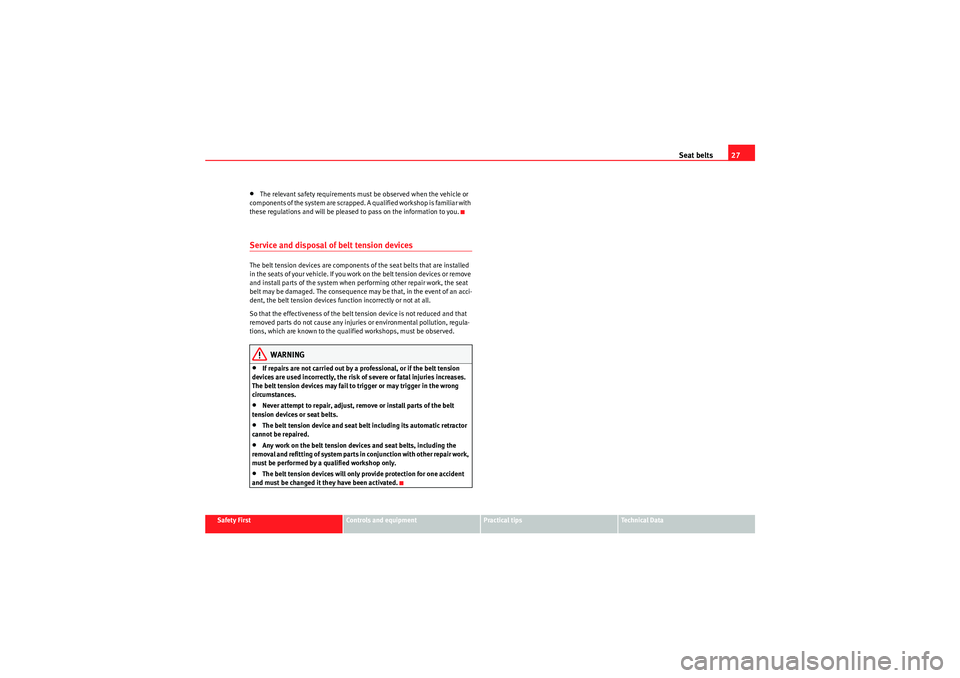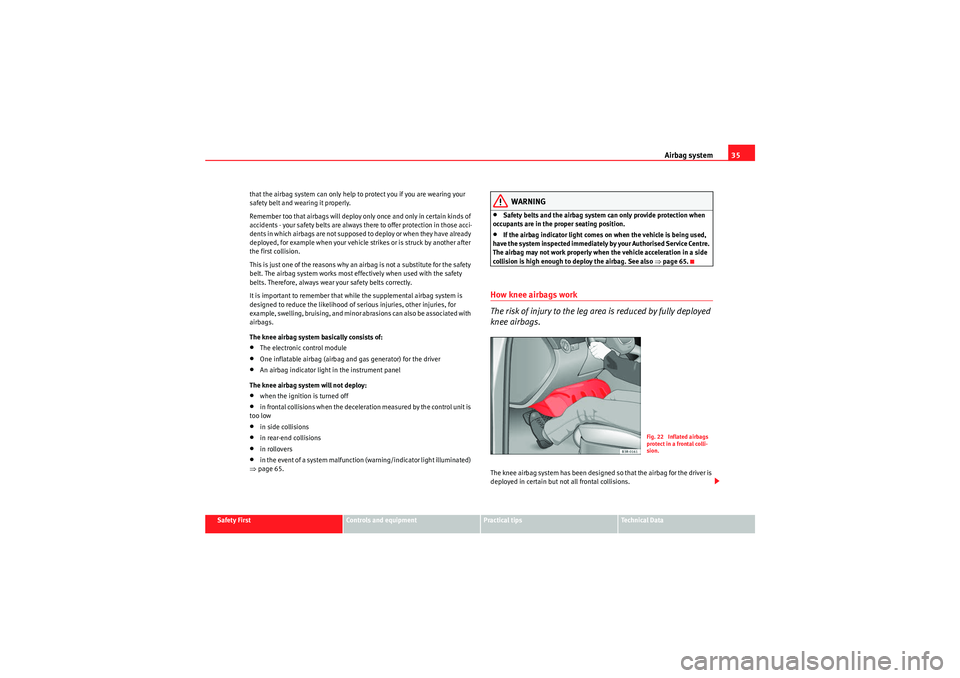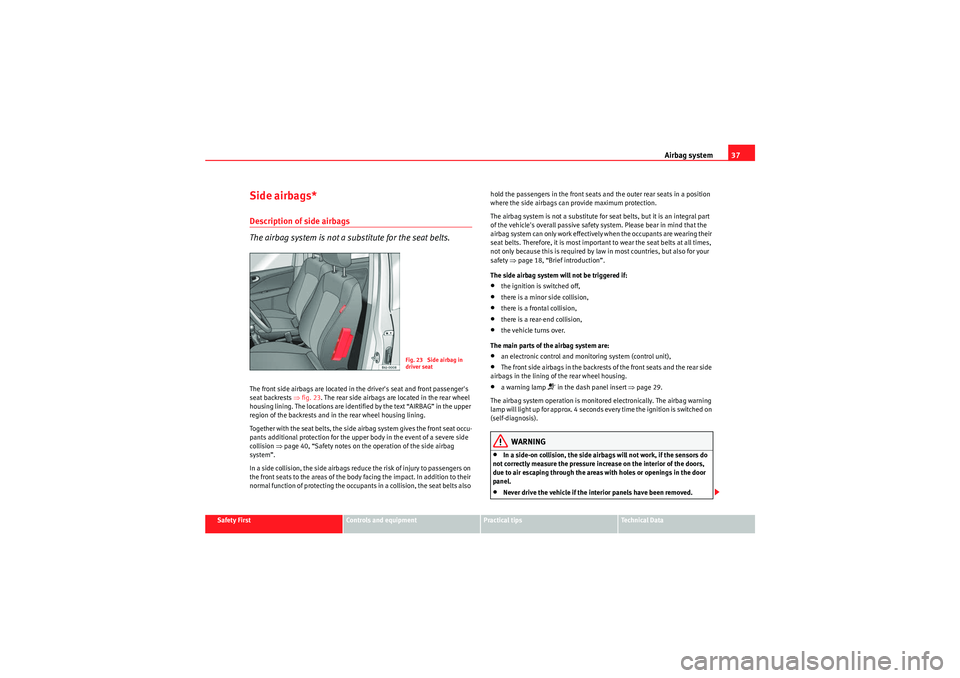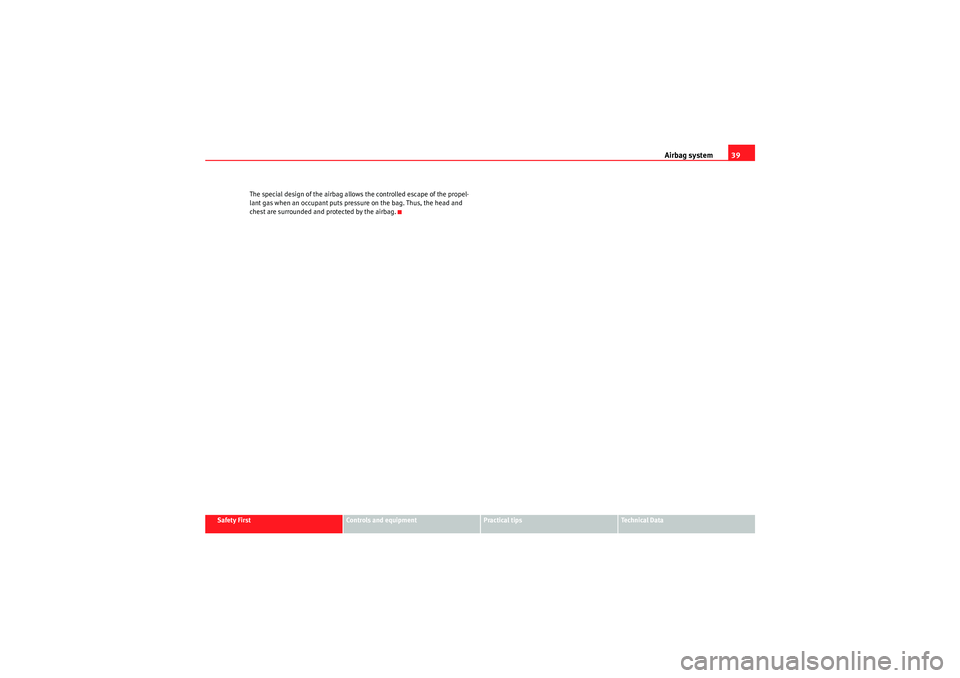technical data Seat Exeo 2009 User Guide
[x] Cancel search | Manufacturer: SEAT, Model Year: 2009, Model line: Exeo, Model: Seat Exeo 2009Pages: 310, PDF Size: 8.54 MB
Page 25 of 310

Seat belts23
Safety First
Controls and equipment
Practical tips
Technical Data
– Adjust the seat and head restraint correctly.
– To fasten the belt, take hold of the latch plate and pull it slowly
across your chest and lap.
– Insert the latch plate into the buckle for the appropriate seat and push it down until it is securely locked with a click ⇒ page 22,
fig. 11 .
– Pull the belt to ensure that the latch plate is securely engaged in the buckle.The seat belts are equipped with an automatic retractor on the shoulder
strap. Full freedom of movement is permitted when the shoulder belt is pulled
slowly. However, during sudden braking, during travel in mountains or bends
and during acceleration, the automatic retractor on the shoulder belt is
locked.
The automatic belt retractors on the front seats are fitted with belt tension
devices ⇒page 26.
WARNING
•An incorrectly worn seat belt web can cause severe injuries in the event
of an accident.•The seat belts offer best protection only when the backrests are in an
upright position and the seat belts have been fastened properly.•Never put the latch plate in the buckle of another seat. If you do this, the
seat belt will not protect you properly and the risk of injury is increased.•I f a n o ccu p an t is i n co r re c t l y be l te d i n , t h e b e l t ca n n o t p ro te c t h i m o r h e r
properly. An incorrectly positioned belt web can cause extremely severe
injuries.
Seat belt position
Seat belts offer their maximum protection only when they are
properly positioned.
Fig. 12 Correct belt web
and head restraint posi-
tions, viewed from frontFig. 13 Correct belt web
and head restraint posi-
tions, viewed from side
Exeo_EN.book Seite 23 Freitag, 28. August 2009 10:14 10
Page 27 of 310

Seat belts25
Safety First
Controls and equipment
Practical tips
Technical Data
WARNING
•An incorrectly worn seat belt web can cause severe injuries in the event
of an accident.•For pregnant women, the lap part of the seat belt must lie as low as
possible over the pelvis, never across the stomach, and always lie flat so
that no pressure is exerted on the abdomen.•Read and observe the warnings ⇒page 21.
Seat belt release
The seat belt must not be unfastened until the vehicle has
come to a standstill.– Press the red button on the belt buckle ⇒fig. 15 . The latch plate
is released and springs out ⇒ . – Guide the belt back by hand so that it rolls up easily and the trim
is not damaged
WARNING
Never unbuckle a seat belt while the vehicle is in motion. If you do, you
increase the risk of sustaining severe or fatal injuries.Seat belt height adjustment
Seat belt height adjusters can be used to adjust the height of
the shoulder area of the seat belt.The belt height adjuster can be lowered by keeping the button
pressed down at the same time.
– Press button ⇒fig. 16 to adjust the belt height.
Fig. 15 Removing latch
plate from buckle
Fig. 16 Belt height
adjustment - top guide
fitting
A1
Exeo_EN.book Seite 25 Freitag, 28. August 2009 10:14 10
Page 29 of 310

Seat belts27
Safety First
Controls and equipment
Practical tips
Technical Data
•The relevant safety requirements must be observed when the vehicle or
components of the system are scrapped. A qualified workshop is familiar with
these regulations and will be pleased to pass on the information to you.Service and disposal of belt tension devicesThe belt tension devices are components of the seat belts that are installed
in the seats of your vehicle. If you work on the belt tension devices or remove
and install parts of the system when performing other repair work, the seat
belt may be damaged. The consequence may be that, in the event of an acci-
dent, the belt tension devices function incorrectly or not at all.
So that the effectiveness of the belt tension device is not reduced and that
removed parts do not cause any injuries or environmental pollution, regula-
tions, which are known to the qualified workshops, must be observed.
WARNING
•If repairs are not carried out by a professional, or if the belt tension
devices are used incorrectly, the risk of severe or fatal injuries increases.
The belt tension devices may fail to trigger or may trigger in the wrong
circumstances.•Never attempt to repair, adjust, remove or install parts of the belt
tension devices or seat belts.•The belt tension device and seat belt including its automatic retractor
cannot be repaired.•Any work on the belt tension devices and seat belts, including the
removal and refitting of system parts in conjunction with other repair work,
must be performed by a qualified workshop only.•The belt tension devices will only provide protection for one accident
and must be changed it they have been activated.
Exeo_EN.book Seite 27 Freitag, 28. August 2009 10:14 10
Page 31 of 310

Airbag system29
Safety First
Controls and equipment
Practical tips
Technical Data
•Always properly adjust the front seats.
The danger of fitting a child seat on the front passenger seat
Rear-facing child seats must never be used on the front
passenger seat when the front passenger airbag is enabled.An enabled front airbag on the front passenger side is potentially a major
danger to a child. The front passenger seat is life threatening to a child if
he/she is transported in a rear-facing child seat. You should always transport
all children up to 12 years of age on the rear seat.
If a rear-facing child seat is secured to the front passenger seat, an inflating
airbag can strike it with such great force that critical or fatal injuries may
result.
Therefore we strongly recommend you to transport children on the rear seats.
That is the safest place for children in the vehicle. Alternatively, the front
passenger airbag can be disabled with a key-operated switch ⇒page 44.
When transporting children, use a child seat appropriate to the age and size
of each child ⇒ page 46.
For those vehicles that do not include a key lock switch to turn the airbag off,
an Authorised Service Centre must be consulted.
WARNING
•If a child seat is secured to the front passenger seat, the risk to the child
of sustaining critical or fatal injuries in the event of an accident increases.•Never secure a rear-facing child seat to the front passenger seat if the
front passenger airbag is enabled. The child can suffer critical or fatal inju-
ries when the front passenger airbag is triggered.
•An inflating front passenger airbag can strike the rear-facing child seat
and hurl it with great force against the door, the roof or the backrest.•If, under special circumstances, it is necessary to transport a child in a
rear-facing child seat on the front passenger seat, it is absolutely essential
that you observe the following safety measures:
−Disable the front passenger airbag ⇒page 44, “Deactivating
airbags*”.
− The child seat must be approved by the child seat manufacturer for
use on a front passenger seat with front or side airbag.
− Follow the installation instructions given by the child seat manufac-
turer and observe the safety instructions ⇒page 46, “Child safety”.
− Before properly installing the child seat, push the front passenger
seat completely backwards so that the greatest possible distance to
the front passenger airbag is ensured.
− Ensure that no objects prevent the front passenger seat from being
pushed completely back.
− The backrest of the front passenger seat must be in an upright
position.
Warning lamp for airbag and belt tension device system
This warning lamp monitors the airbag and belt tension
device system.The warning lamp monitors all airbags and belt tension devices in the
vehicle, including control units and wiring connections.
WARNING (continued)
WARNING (continued)
Exeo_EN.book Seite 29 Freitag, 28. August 2009 10:14 10
Page 33 of 310

Airbag system31
Safety First
Controls and equipment
Practical tips
Technical Data
Front airbagsDescription of front airbags
The airbag system is not a substitute for the seat belts.
The front airbag for the driver is located in the steering wheel ⇒fig. 17 and
the airbag for the front passenger is located in the instrument panel
⇒ fig. 18 . Airbags are identified by the word “AIRBAG”. On the driver's side,
the knee airbag* is found in the front footwell, under the instrument panel.
In conjunction with the seat belts, the front airbag system gives the front
occupants additional protection for the head and chest in the event of a
severe frontal collision ⇒page 34, “Safety notes on the frontal airbag
system”.
In addition to their normal function of restraining the occupants, the seat
belts also hold the driver and front passenger in a position where the airbags
can provide maximum protection in a frontal collision.
The airbag system is not a substitute for seat belts, but it is an integral part
of the vehicle's overall passive safety system. Please bear in mind that the
airbag system can only work effectively when the occupants are wearing their
seat belts correctly and have adjusted the head restraints properly. Therefore,
it is most important to wear the seat belts at all times, not only because this
is required by law in most countries, but also for your safety ⇒page 18,
“Brief introduction”.
Fig. 17 Driver's Airbag in
the steering wheel and
knee airbag in the instru-
ment panel
Fig. 18 Front passenger
airbag located in dash
panel
Exeo_EN.book Seite 31 Freitag, 28. August 2009 10:14 10
Page 35 of 310

Airbag system33
Safety First
Controls and equipment
Practical tips
Technical Data
may develop when the airbag deploys. This is normal and it is not an indica-
tion of fire in the vehicle.
Airbag covers when the frontal airbags are triggeredThe airbag covers fold out of the steering wheel or instrument panel when the
driver's and front passenger's airbags are triggered
⇒fig. 20 . The airbag
covers remain connected to the steering wheel or the dash panel.
Fig. 20 Airbag covers reacting when the front airbags
are triggered
Exeo_EN.book Seite 33 Freitag, 28. August 2009 10:14 10
Page 37 of 310

Airbag system35
Safety First
Controls and equipment
Practical tips
Technical Data
that the airbag system can only help to protect you if you are wearing your
safety belt and wearing it properly.
Remember too that airbags will deploy only once and only in certain kinds of
accidents - your safety belts are always there to offer protection in those acci-
d e nts i n whi ch a ir ba gs a re not supp os ed t o de ploy or wh en the y hav e alr ead y
deployed, for example when your vehicle strikes or is struck by another after
the first collision.
This is just one of the reasons why an airbag is not a substitute for the safety
belt. The airbag system works most effectively when used with the safety
belts. Therefore, always wear your safety belts correctly.
It is important to remember that while the supplemental airbag system is
designed to reduce the likelihood of serious injuries, other injuries, for
example, swelling, bruising, and minor abrasions can also be associated with
airbags.
The knee airbag system basically consists of:
•The electronic control module•One inflatable airbag (airbag and gas generator) for the driver•An airbag indicator light in the instrument panel
The knee airbag system will not deploy:•when the ignition is turned off•in frontal collisions when the deceleration measured by the control unit is
too low•in side collisions•in rear-end collisions•in rollovers•in the event of a system malfunction (warning/indicator light illuminated)
⇒ page 65.
WARNING
•Safety belts and the airbag system can only provide protection when
occupants are in the proper seating position.•If the airbag indicator light comes on when the vehicle is being used,
have the system inspected immediately by your Authorised Service Centre.
The airbag may not work properly when the vehicle acceleration in a side
collision is high enough to deploy the airbag. See also ⇒page 65.
How knee airbags work
The risk of injury to the leg area is reduced by fully deployed
knee airbags.The knee airbag system has been designed so that the airbag for the driver is
deployed in certain but not all frontal collisions.
Fig. 22 Inflated airbags
protect in a frontal colli-
sion.
Exeo_EN.book Seite 35 Freitag, 28. August 2009 10:14 10
Page 39 of 310

Airbag system37
Safety First
Controls and equipment
Practical tips
Technical Data
Side airbags*Description of side airbags
The airbag system is not a substitute for the seat belts.The front side airbags are located in the driver's seat and front passenger's
seat backrests ⇒fig. 23. The rear side airbags are located in the rear wheel
housing lining. The locations are identified by the text “AIRBAG” in the upper
region of the backrests and in the rear wheel housing lining.
Together with the seat belts, the side airbag system gives the front seat occu-
pants additional protection for the upper body in the event of a severe side
collision ⇒page 40, “Safety notes on the operation of the side airbag
system”.
In a side collision, the side airbags reduce the risk of injury to passengers on
the front seats to the areas of the body facing the impact. In addition to their
normal function of protecting the occupants in a collision, the seat belts also hold the passengers in the front seats and the outer rear seats in a position
where the side airbags can provide maximum protection.
The airbag system is not a substitute for seat belts, but it is an integral part
of the vehicle's overall passive safety system. Please bear in mind that the
airbag system can only work effectively when the occupants are wearing their
seat belts. Therefore, it is most important to wear the seat belts at all times,
not only because this is required by law in most countries, but also for your
safety
⇒page 18, “Brief introduction”.
The side airbag system will not be triggered if:
•the ignition is switched off,•there is a minor side collision,•there is a frontal collision,•there is a rear-end collision,•the vehicle turns over.
The main parts of the airbag system are:•an electronic control and monitoring system (control unit),•The front side airbags in the backrests of the front seats and the rear side
airbags in the lining of the rear wheel housing.•a warning lamp
in the dash panel insert ⇒page 29.
The airbag system operation is monitored electronically. The airbag warning
lamp will light up for approx. 4 seconds every time the ignition is switched on
(self-diagnosis).
WARNING
•In a side-on collision, the side airbags will not work, if the sensors do
not correctly measure the pressure increase on the interior of the doors,
due to air escaping through the areas with holes or openings in the door
panel.•Never drive the vehicle if the interior panels have been removed.
Fig. 23 Side airbag in
driver seat
Exeo_EN.book Seite 37 Freitag, 28. August 2009 10:14 10
Page 41 of 310

Airbag system39
Safety First
Controls and equipment
Practical tips
Technical Data
The special design of the airbag allows the controlled escape of the propel-
lant gas when an occupant puts pressure on the bag. Thus, the head and
chest are surrounded and protected by the airbag.
Exeo_EN.book Seite 39 Freitag, 28. August 2009 10:14 10
Page 43 of 310

Airbag system41
Safety First
Controls and equipment
Practical tips
Technical Data
Curtain airbagsDescription of curtain airbags
The airbag system is not a substitute for the seat belts.The curtain airbags are located on both sides in the interior above the doors
⇒fig. 25 and are identified with the text “AIRBAG”.
In conjunction with the seat belts, the curtain airbag system gives the occu-
pants additional protection for the head and upper body in the event of a
severe side collision ⇒ page 42, “Safety notes on the operation of the
curtain airbag system”.
The airbag system is not a substitute for seat belts, but it is an integral part
of the vehicle's overall passive safety system. Please bear in mind that the
airbag system can only work effectively when the occupants are wearing their
seat belts correctly and have adjusted the head restraints properly. Therefore,
it is most important to wear the seat belts at all times, not only because this is required by law in most countries, but also for your safety
⇒page 18,
“Brief introduction”.
The main parts of the curtain airbag system are:
•an electronic control and monitoring system (control unit),•the curtain airbags (airbags with ga s generator) for the driver, front
passenger and passengers on the rear seats,•a warning lamp
in the dash panel insert ⇒page 29.
The airbag system operation is monitored electronically.
The curtain airbag system will not be triggered
•the ignition is switched off,•there is a frontal collision,•there is a rear-end collision,•if the vehicle rolls,•during a minor side collision,WARNING
If a fault has occurred in the airbag system, have the system checked imme-
diately by a qualified workshop. Otherwise there is a danger that during a
collision, the system may fail to trigger, or not trigger correctly.
Fig. 25 Location of left
curtain airbag
Exeo_EN.book Seite 41 Freitag, 28. August 2009 10:14 10